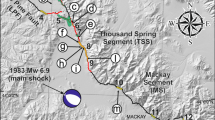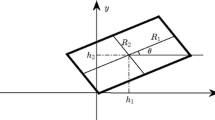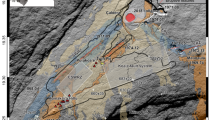Abstract
Fault surface roughness is a principal factor influencing earthquake mechanics, and particularly rupture initiation, propagation, and arrest. However, little data currently exist on fault surfaces at seismogenic depths. Here, we investigate the roughness of slip surfaces from the seismogenic strike-slip Gole Larghe Fault Zone, exhumed from ca. 10 km depth. The fault zone exploited pre-existing joints and is hosted in granitoid rocks of the Adamello batholith (Italian Alps). Individual seismogenic slip surfaces generally show a first phase of cataclasite production, and a second phase with beautifully preserved pseudotachylytes of variable thickness. We determined the geometry of fault traces over almost five orders of magnitude using terrestrial laser-scanning (LIDAR, ca. 500 to <1 m scale), and 3D mosaics of high-resolution rectified digital photographs (10 m to ca. 1 mm scale). LIDAR scans and photomosaics were georeferenced in 3D using a Differential Global Positioning System, allowing detailed multiscale reconstruction of fault traces in Gocad®. The combination of LIDAR and high-resolution photos has the advantage, compared with classical LIDAR-only surveys, that the spatial resolution of rectified photographs can be very high (up to 0.2 mm/pixel in this study), allowing for detailed outcrop characterization. Fourier power spectrum analysis of the fault traces revealed a self-affine behaviour over 3–5 orders of magnitude, with Hurst exponents ranging between 0.6 and 0.8. Parameters from Fourier analysis have been used to reconstruct synthetic 3D fault surfaces with an equivalent roughness by means of 2D Fourier synthesis. Roughness of pre-existing joints is in a typical range for this kind of structure. Roughness of faults at small scale (1 m to 1 mm) shows a clear genetic relationship with the roughness of precursor joints, and some anisotropy in the self-affine Hurst exponent. Roughness of faults at scales larger than net slip (>1–10 m) is not anisotropic and less evolved than at smaller scales. These observations are consistent with an evolution of roughness, due to fault surface processes, that takes place only at scales smaller or comparable to the observed net slip. Differences in roughness evolution between shallow and deeper faults, the latter showing evidences of seismic activity, are interpreted as the result of different weakening versus induration processes, which also result in localization versus delocalization of deformation in the fault zone. From a methodological point of view, the technique used here is advantageous over direct measurements of exposed fault surfaces in that it preserves, in cross-section, all of the structures which contribute to fault roughness, and removes any subjectivity introduced by the need to distinguish roughness of original slip surfaces from roughness induced by secondary weathering processes. Moreover, offsets can be measured by means of suitable markers and fault rocks are preserved, hence their thickness, composition and structural features can be characterised, providing an integrated dataset which sheds new light on mechanisms of roughness evolution with slip and concomitant fault rock production.











Similar content being viewed by others
References
Allen, J.L. (2005), A multi-kilometer pseudotachylyte system as an exhumed record of earthquake rupture geometry at hypocentral depths (Colorado, USA), Tectonophysics 402, 37-54.
Amitrano, D., and Schmittbuhl, J. (2002), Fracture roughness and gouge distribution of a granite shear band, Journal of Geophysical Research, 107 (B12), 2375, doi:10.1029/2002JB001761.
Ben-Zion, Y., and Sammis, C. (2003), Characterization of fault zones, Pure and Applied Geophysics 160, 677-715.
Bierme, H., Meeschaert, M.M., and Scheffler, H.-P. (2007), Operator scaling stable random fields, Stochastic Processes and their Applications 117, 312-332.
Bistacchi, A., Massironi, M., and Menegon, L. (2010), Three-dimensional characterization of a crustal-scale fault zone: the Pusteria and Sprechenstein fault system (Eastern Alps), Journal of Structural Geology, 32, 2022-2041.
Brown, S.R., and Scholz, C.H. (1985), Broad bandwidth study of the topography of natural rock surfaces, Journal of Geophysical Research 90, 12575-12582.
Candela, T., Renard, F., Bouchon, M., Brouste, A., Marsan, D., Schmittbuhl, J., and Voisin C. (2009), Characterization of fault roughness at various scales: implications of three-dimensional high resolution topography measurements, Pure and Applied Geophysics 166 (10), 1817-1851, DOI:10.1007/s00024-009-0521-2.
Clausel, M., and Vedel, B. (2009), Explicit constructions of operator scaling stable random Gaussian fields, Submitted to Advances in Applied Probability.
Di Toro, G., and Pennacchioni G. (2005), Fault plane processes and mesoscopic structure of a strong-type seismogenic fault in tonalites (Adamello batholith, Southern Alps), Tectonophysics 402, 55-80.
Di Toro, G., Pennacchioni, G., and Nielsen, S., Pseudotachylytes and Earthquake Source Mechanics, In Fault-zone Properties and Earthquake Rupture Dynamics (ed. Eiichi Fukuyama) (International Geophysics Series, Elsevier, 2009) pp. 87-133.
Di Toro, G., Niemeijer, A.R., Tripoli A., Nielsen S., Di Felice F., Scarlato P., Spada G., Alessandroni R., Romeo G., Di Stefano G., Smith S. and Mariano S. (2010), From field geology to earthquake simulation: a new state-of-the-art tool to investigate rockfriction during the seismic cycle (SHIVA). Rendiconti Lincei 21 (Suppl 1) 95-114.
Ecker, M.D., and Gelfand, A.E. (1999), Bayesian modeling and inference for geometrically anisotropic spatial data, Mathematical Geology 31 (1), 67-83.
Griffith, W.A., Di Toro, G., Pennacchioni, G., and Pollard, D.D. (2008), Thin pseudotachylytes in Faults of the Mt. Abbot Quadrangle, Sierra Nevada : physical constraints for small seismic slip events, Journal of Structural Geology, 30, 1086-1094.
Grocott, J. (1981), Fracture geometry of pseudotachylyte generation zones: a study of shear fractures formed during seismic events, Journal of Structural Geology 3, 169-178.
James, J.F., A Student’s Guide to Fourier Transforms, with Applications in Physics and Engineering, 2nd Ed. (Cambridge University Press, Cambridge 2002).
Kraus, K., Photogrammetry, 2nd Ed. (De Gruyter, Berlin 2007).
Lee, J.-J., and Bruhn, R.L. (1996), Structural anisotropy of normal fault surfaces. Journal of Structural Geology 18 (8), 1043-1059.
Mallet, J.-L., Geomodeling (Oxford University Press, Oxford 2002).
Mandelbrot, B.B., The fractal geometry of nature (W. H. Freeman, New York 1982).
Mandelbrot, B.B. (1985), Self-affine fractals and fractal dimension, Physics Scripta 32, 257-260.
Pennacchioni, G., Di Toro, G., Brack, P., Menegon, L., and Villa, I. M. (2006), Brittle-ductile-brittle deformation during cooling of tonalite (Adamello, Southern Italian Alps), Tectonophysics 427(1-4), 171-197.
Power, W.L., Tullis, T.E., Brown, S.R., Boitnott, G.N., and Scholz C.H. (1987), Roughness of natural fault surfaces, Geophysical Research Letters 14 (1), 29-32.
Power, W.L., Tullis, T.E., and Weeks, J.D. (1988), Roughness and wear during brittle faulting, Journal of Geophysical Research 93 (B12), 15268-15278.
Press, W.H., Teukolsky, S.A., Vetterling, W.T., and Flannery, B.P., Numerical Recipes, 3rd Ed. (Cambridge University Press 2007).
Renard, F., Voisin, C., Marsan, D., and Schmittbuhl, J. (2006), High resolution 3D laser scanner measurements of a strike-slip fault quantify its morphological anisotropy at all scales, Geophysical Research Letters 33 (L04305), doi:10.1029/2005GL025038.
Sagy, A., and Brodsky, E.E. (2009), Geometric and rheological asperities in an exposed fault zone, Journal of Geophysical Research 114, B02301.
Sagy, A., Brodsky, E.E., and Axen, G.J. (2007), Evolution of fault-surface roughness with slip, Geology 35 (3), 283-286.
Schmittbuhl, J., Gentier, S., and Roux, S. (1993), Field measurements of the roughness of fault surfaces, Geophysical Research Letters 20 (8), 639-641.
Schmittbuhl, J., Schmitt, F., and Scholz, C.H. (1995a), Scaling invariance of crack surfaces, Journal of Geophysical Research 100 (B4), 5953-5973.
Schmittbuhl, J., Vilotte, J.-P., and Roux, S. (1995b), Reliability of self-affine measurements, Physical Review E 51 (1), 131-147.
Scholz, C.H., The Mechanics of Earthquakes and Faulting 2nd Ed. (Cambridge University Press, New York 2002).
Schuster, A. (1898), On the investigation of hidden periodicities with application to a supposed 26 day period of meteorological phenomena, Terrestrial Magnetism and Atmospheric Electricity 3, 13-41.
Swanson, M.T. (1988), Pseudotachylyte-bearing strike-slip duplex structures in the Fort Foster Brittle Zone, S. Maine, Journal of Structural Geology 10, 813-828.
Thomson, D.J. (1982), Spectrum estimation and harmonic analysis, Proceedings IEEE 70, 1055-1096.
Welch, P.D. (1967), The use of fast Fourier transform for the estimation of power spectra: a method based on time averaging over short, modified periodograms, IEEE Transactions on Audio Electroacoustics AU-15, 70-73.
Wu, J.-J. (2002), Analyses and simulation of anisotropic fractal surfaces, Chaos, Solitons and Fractals 13 (9), 1791-1806.
Acknowledgments
Fieldwork, meso-scale structural analysis and photomosaic collection was carried out by AB and WAG. Lidar data collection, processing and interpretation was performed by SAS and RJ. Photogrammetry and photomosaic processing, interpretation and 3D data integration by AB. The Matlab® toolbox used for the analysis was developed by AB (who also carried out the analysis), with contributions by WAG and SN. GDT developed and coordinated the project, and introduced the team to the GLFZ. The paper was written by AB with contributions from all the co-authors. This study is funded by the European Research Council Starting Grant Project 205175 USEMS (http://www.roma1.ingv.it/laboratori/laboratorio-hp-ht/usems-project). WAG was funded by the National Science Foundation grant OISE-0754258. The Gocad Research Group and Paradigm Geophysical are acknowledged for welcoming Padova University into the Gocad Consortium (http://www.Gocad.org). The Provincia Autonoma di Trento Geological Survey is acknowledged for providing aerial LIDAR data. Elena Spagnuolo is warmly acknowledged for useful suggestions on the Fourier analysis section. Silvia Mittempergher and Andrè Niemeijer are thanked for sharing hard days working with the DGPS on the Lobbia outcrops.
Author information
Authors and Affiliations
Corresponding author
Rights and permissions
About this article
Cite this article
Bistacchi, A., Griffith, W.A., Smith, S.A.F. et al. Fault Roughness at Seismogenic Depths from LIDAR and Photogrammetric Analysis. Pure Appl. Geophys. 168, 2345–2363 (2011). https://doi.org/10.1007/s00024-011-0301-7
Received:
Revised:
Accepted:
Published:
Issue Date:
DOI: https://doi.org/10.1007/s00024-011-0301-7




